Why Wall and Drapery Colors Matter in Home Décor
When decorating a room, one question often arises: Should drapes match the wall color? Drapes are more than just fabric; they frame your windows, add warmth, and complete the look of your space. The color you choose for your drapes can make a room feel cozy, bright, or balanced. Picking the right shade also helps tie together your furniture, flooring, and wall paint for a polished finish.
The role of drapes goes beyond blocking sunlight or adding privacy. They can set the tone for your entire room. If chosen carefully, drapes can enhance your wall color, make ceilings look taller, or even change how light fills the space. Because of this, the relationship between your wall color and your drapery color is worth considering early in your design plan.
When drapes and wall colors are in harmony, your room feels intentional and thoughtfully designed. On the other hand, clashing colors can make the room feel disconnected or chaotic. Whether you’re redecorating one room or the whole house, understanding how drapes and wall colors interact will help you make confident choices.
Understanding Color Balance in a Room
Color balance refers to ensuring that no single color dominates the room. Your walls set the main tone, while your drapes either blend in or stand out. If you have light-colored walls, consider using darker drapes for added contrast. On the other hand, similar tones between walls and curtains can make a space feel calm and seamless.
When working with color balance, think about the 60-30-10 rule. This design guideline suggests that 60% of the room should be your main color (often the walls), 30% a secondary color (which could be your drapes or furniture), and 10% an accent color for visual interest. Drapes often fall into either the 30% or 10% category, so their color choice can make a big difference.
Natural light also plays a role. South-facing rooms with lots of sunlight may handle deeper or cooler drape colors without feeling dark, while north-facing rooms might benefit from lighter or warmer tones to brighten the space.
Should Drapes Match Wall Color? The Key Considerations

There’s no single “right” answer. Drapes that match the wall color can create a soft, unified look. This works well in small rooms because it makes them feel bigger and less busy. However, if you prefer a bolder style, you can choose a curtain color combination that contrasts with your walls. The choice depends on your design taste, room size, and how much natural light you have.
For example, cream walls with cream curtains create a relaxing and seamless feel. This is especially nice in bedrooms where you want a calming environment. On the other hand, pairing beige walls with navy drapes can create a dramatic and elegant statement, perfect for formal dining rooms.
Your furniture style also matters. Traditional spaces often benefit from more tonal harmony, while modern or eclectic designs welcome bolder contrasts.
Matching Drapes with Wall Colors: When It Works Best
- If your goal is to make the space feel open and calm, matching drapes with wall colors works beautifully.
- Cream walls with cream curtains or beige walls with beige drapes give a smooth, hotel-like finish.
- Using the same or similar tones can highlight other design features, like artwork or furniture, without distraction.
- This approach works especially well if your wall color is neutral.
- Neutrals like beige, cream, and light gray give you the flexibility to match your drapes exactly or choose a shade just slightly lighter or darker.
- This subtle change keeps the look cohesive without being too flat.
- Another benefit of matching is that it can make your ceilings appear higher.
- When the drapery blends with the walls, it creates an unbroken line of color, drawing the eye upward.
When to Choose Drapes in a Contrasting Color
Sometimes, you want your drapes to stand out. If your walls are a light neutral, deep navy, charcoal, or even patterned drapes can add personality. Contrasting colors work well in living rooms or bedrooms where you want to create a visual point of interest. This is also a great choice if you’re mixing modern and classic design elements.
Contrasts are particularly effective in rooms where the walls are pale but the furniture has richer tones. For instance, beige walls paired with forest green drapes can tie in with dark wood furniture and bring a natural, grounded feel to the space.
When using contrast, it’s important to connect the drapery color to another element in the room. For example, if your drapes are a bold terracotta, you could include throw pillows or a rug with the same tone.
Should Drapes Be Lighter or Darker Than Walls?

Lighter drapes make a room feel airy, especially with darker walls. Darker drapes, on the other hand, add drama and depth, especially with light-colored walls. The trick is to pick a shade that complements your walls without clashing. A good rule is to stay within two to three shades lighter or darker than your wall color.
If your walls are light gray, soft white, or light beige, the drapes can create a fresh look. With dark blue walls, lighter drapes like cream or pale gray can help balance the richness. Likewise, dark drapes against white walls create strong visual lines, giving the space a structured feel.
Curtain and Wall Color Combinations for Popular Shades
Neutral walls, like beige, cream, or gray, are the easiest to pair with different curtain colors. Beige walls look beautiful with white curtains for a crisp feel or with gray curtains for a modern touch. Cream walls can handle warm-toned drapes, like gold or tan, for a cozy feel. If your walls are gray, try white, charcoal, or soft blue drapes for a timeless match.
For bolder wall colors, the key is balance. Yellow walls pair well with gray or navy drapes to tone down brightness. Blue walls look fresh with white or beige curtains, while green walls can work with cream or patterned drapes for an earthy style.
Best Drapery Choices for Beige and Cream Walls
Beige and cream walls work with almost any curtain color. For a calm look, choose beige curtains with gray walls or white curtains with beige walls. If you want contrast, go for navy, forest green, or patterned drapes. The key is to keep the curtain color connected to at least one other element in the room, such as a rug or throw pillows.
Beige curtains with gray walls create a modern yet warm look, while beige walls with gray curtains bring depth and dimension. Cream walls and cream curtains are elegant but can be livened up with textured fabrics or subtle patterns.
Expert Advice from Made in the Shade Blinds in Pearland
At Made in the Shade Blinds, we’ve helped many homeowners find the perfect match between wall colors and drapes. Whether you’re choosing curtains for beige walls or cream walls, the right choice depends on your style, lighting, and room size. Our team can guide you through fabric textures, color samples, and combinations that bring your vision to life.
We also help homeowners decide when to match curtains with wall colors and when to go bold with contrasts. The right decision isn’t just about trends — it’s about creating a home you love coming back to every day.
If you want your drapes to look like they were made for your room, we can help you find the perfect fit. Contact Made in the Shade Blinds today to explore custom options that match your style and home.



